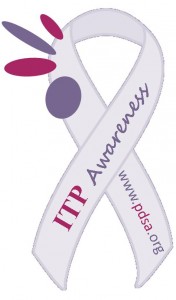
ITP Awareness Ribbon
Way way back when I started working in healthcare research one of the first projects i worked on was to recruit parents of children with ITP.
You can of course image my response!
“What is ITP?”
And then an immediate rush over to Wikipedia. I then discovered it was a bleeding disorder.
So I am very happy to share with you some information from The Platelet Disorder Support Association which supports people with Immune Thrombocytopenia and other platelet disorders. They have a pretty useful web site which you can check out here.
“Imagine being told that your child cannot play on the playground with other kids, ride a bike, participate in normal
childhood activities or contact sports because a bump, cut, or impact to their head could lead to life-threatening bleeding.
Now imagine trying to get emergency help for your bleeding child and being accused of abuse because your child is
covered with bruises. As an adult, imagine waking up in the morning with a mouth full of blood blisters, heading off to
work with a nosebleed that won’t stop for hours, or going to bed at night with a headache and fearing you’re having a
brain hemorrage and won’t wake up in the morning. This is life for someone suffering with the bleeding disorder ITP.
Immune Thrombocytopenia (ITP) is a condition in which the blood has a lower number of platelets than normal. Platelets
are cells that help the blood clot. ITP is called an autoimmune disease since it is the result of the body’s immune system
attacking platelets as if they are foreign cells. A person with ITP is at a higher risk of bleeding. ITP is often accompanied
by fatigue and sometimes depression and has a profound impact on a person’s quality of life.
ITP affects almost 10 times as many people as hemophilia, yet most people know nothing about it. This lack of public
awareness leaves many ITP patients feeling isolated and alone, and is the main reason why there is so little support for
research on ITP and the lack of advancement in treatment. ITP is a growing but little understood health problem that most
people (including some medical professionals) have never heard of. It affects individuals of all ages, sexes, and ethnic
origins.
This September patients of all ages, along with family members and health care providers, will come together for National
ITP Awareness Month and Sport Purple for Platelets Day.”
So please share the image above on social media to show your support for people with IPP.
Thanks in advance
More information on ITP from The Platelet Disorder Support Association
“ITP, immune (idiopathic) thrombocytopenic purpura, is an autoimmune disease. In autoimmune diseases, the body mounts an immune attack toward one or more seemingly normal organ systems. In ITP, platelets are the target. They are marked as foreign by the immune system and eliminated in the spleen and sometimes, the liver. In addition to increased platelet destruction, some people with ITP also have impaired platelet production.
Platelets are relatively small, irregularly shaped components of our blood. They are required to maintain the integrity of our blood vessel walls and for blood to clot. Without a sufficient number of platelets, a person with ITP is subject to spontaneous bleeding or bruising.
People with ITP often have bruises or small purple spots on their skin (petechiae) where their blood has escaped from their veins or capillaries. Spontaneous bleeding can also occur in the mucus membranes on the inside of the mouth or in the gastro-intestinal tract. It is possible, with a decreased number of platelets, to have a spontaneous cerebral hemorrhage. ITP is often accompanied by fatigue and sometimes depression.
Normal platelet counts range from 150,000 to 400,000 per microliter of blood. People with platelet counts under 10,000 have a severe case of ITP. 30,000 is sufficient for many to prevent a catastrophic bleed. Individual reactions to low platelet counts differ. Determining a safe platelet count is a decision to be made in consultation with an experienced treating physician.
The number of individuals in the United States with ITP has been estimated to be approximately 200,000. Our survey indicates that ITP occurs more frequently in women than men during childbearing years. It is usually a chronic problem. ITP in children occurs at about the same rate in boys and girls. It is frequently self-correcting but may become chronic. Adolescent ITP has more of the characteristics of adult ITP.
While most cases of ITP are controlled, it can be fatal in a small percentage of ITP patients.”




